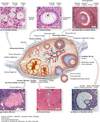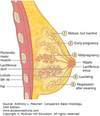Histo - Female Flashcards
(36 cards)
What are the components of the ovaries?
Basics:
- 2 ovaries present
- each has hilum
- suspended from mesenteries
- has cortex & medulla
Histo:
- Covered w/ germinal epithelium
- simple cuboidal lining
- continuous w/ mesothelium
- NOT germinal
- Tunica albuginea = deep to germinal epithelium

What is this?

Ovary Cortex and Medulla
Cortex:
- ovarian follicles
- stroma w/ CT
Medulla:
- loose CT & blood vessels
- blood vessels enter from hilum

What are Ovarian Follicles?
Basics:
- follicle = oocyte + cells surrounding it
- enlarge as they develop –> increasing the cell layers that surround them
Cells surrounding oocyte:
- Follicular cells or granulosa cells (w/in BL)
- Thecal cells (outside BL)
Stages:
- Primordial
- Primary
- unilaminar
- multilaminar
- Secondary
- Tertiary
What are the different stages of follicle development in the ovary?

Follicular Development
- Primordial follicles
- Primary follicles
- unilaminar
- multilaminar
- Secondary follicle aka Antral
- antrum forms
- Tertiary follicle aka Graafian follicle
- antrum expands & becomes mature

What is this?

Primordial - Follicle in Ovary
Primordial
- single layer of flattened follicular cells around the oocyte
- BL surrounds it
- becomes primary oocyte
Location
- outer cortex
What is this?

Primary Follicles
Unilaminar
- has primary oocyte
- has single layer of cuboidal follicular cells
- Zone pellucida forms
- BL around oocyte
Multilaminar
- has primary oocyte
- has multiple layers of follicular cells (granulosa cells)
- Theca begins to organize
- Zone pellucida

What is this?

Secondary & Tertiary Follicles - in Ovary
Secondary follicle:
- start of antrum = callexner bodies
- contains follicular fluid made by follicluar (granulosa) cells
- can have complete antrum… but do not protrude from ovary
- smaller
- multiple layers of granulosa cells
- theca organized
- zona pelucida
Tertiary (Mature or Graafian) follicle:
- secondary oocyte
- zona pellucida
- corona radiata
- antrum complete = continuous + large
- protrudes from surface of ovary when read to ovulate
- 1 or 2 per cycle undergo ovulation (others becocme atretic)
- granulosa cell
- theca organized

What is this?

Follicular Structures

What is this?

Theca Interna & Externa
Theca Interna
- Steroid secreting cells
- Vacuolated
Theca Externa
- Fibroblasts
What is the difference between primary & secondary oocyte?
Primary oocyte
- meiosis arrested in prophase I
- meiosis I = completed prior to ovulation
- meiosis II = starts & arrests in metaphase II
- now = secondary oocyte in mature follicle
Secondary oocyte
- ovulates
- if fertilized, meiosis II = complete
- second polar body
What is this?

Atresia
- Degeneration
- can happen at any stage of follicle development
- Apoptosis of granulosa cells
- Autolysis of oocyte
- Macrophages do clean up
What phase is Oogenesis suspended in during childhood?
Meiosis I (Prophase I)

What is the Hormonal Regulation of Ovarian Function?
Hormonal Regulation of Ovaries
- Hypothalamus secretes GnRH
- stimulates anterior pituitary (AP)
- FSH & LH released
- stimulate follicular development
- Maturing ovarian follicles
- secrete inhibin (inhibits FSH production)
- low levels of estrogen (initially inhibits both the hypothalamus & AP)
- Estrogen (low levels)
- assists w/ dev of vesicular follicle
- Vesicular follicle
- produces a large threshold amount of estrogen
- stimulates the hypothalamus & AP
- produces a large threshold amount of estrogen
-
LH surge from the AP
- induces ovulation
-
Corpus luteum forms
- due to influence of LH
- Corpus luteum secretes large amounts of progesterone, estrogen, inhibin
- inhibits hypothalamus & AP

What happens during Ovulation?
Ovulation
- LH surge = causes ovulation
- Graafian follicle ruptures
- Causes oocyte w/ surrounding cells, blood & follicular fluid to leave the ovary
- if contacts peritoneum = cause mid-cycle lower abd pain
If secondary oocyte in meiosis II metaphase is fertilized…
- meiosis II = completes
- LH causes follicle to become a corpus luteum
- becomes corpus albicans
What is this?

Corpus Luteum
After ovulation:
- follicle involutes
-
theca interna cells —> theca lutein cells
- darker staining cells than granulosa lutein cells
-
follicular cells —> granulosa lutein cells
- ligher staining cells than theca lutein cells
- theca externa contracts
- granulosa cells collapse
- theca interna cells INVADE into granulosa cells
If NO fertilization:
- involutes w/in 14 days into a corpus albicans
If fertilization:
- involutes w/in 6 months to corpus albicans

What are the 2 Types of Corpora Lutea?
Corpus Luteum of Menstruation
- persists for part of 1 cycle
- phagocytosed by macrophages
- forms a corpus albicans
Corpus Luteum of Pregnancy
- uterine mucosa cannot menstruate (would lose embryo)
- corpus luteum of pregnancy = maintain by HCG
- 4-5 months until placenta makes progesterone & estrogen
- then becomes a corpus albicans
What is this?

Corpus Albicans
- Scar tissue
- Macrophages phagocytose debris
-
Hemosiderin in macrophages
- brown color
What are the Parts of the Uterine Tubes?
-
Fimbriae & infundibullum
- catches oovum
- large open space w/ folds
-
Ampulla
- where fertilzation takes place
-
Isthmus
- narrowing near the uterus
-
Intramural segment
- opens to uterus

What is this?

Mucosa of the Uterine Tube Wall
Layers of Oviduct
-
Mucosa
- simple columnar epithelium
- ciliated cell
- partially responsible for movement of ovum (mostly occurs via tubal peristalsis)
- secretory non-ciliated (aka Peg Cells)
- produce tubal fluids rich in K+, Cl-, and Ig’s
- nutrition; helps move egg along
- ciliated cell
- lamina propria
- simple columnar epithelium
- Muscle
-
Serosa
- simple squamous

What is this?

Oviduct Fimbriae
What is this?

Oviduct Isthmus
- blood vessels
- peg cells & ciliated cells in epithelium
What is this?

Infundibulum of Oviduct
- lots of mucosal folds
- little bit of muscle on outter edge

What is this?

Uterus
Endometrium
-
mucosa (lined by simple columnar epithelium; some ciliated)
- stratum basalis
- stratum functionalis (shed during menstruation)
Myometrium
- 3 layers of smooth muscle
Serosa or Adventitia
- continuous w/ perimetrium
Body & Fundus
- cervix

What is the Arterial Supply to the Endometrium?
Straight arteries
- supply stratum basale
Spiral arteries
- extend further
- supply stratum functionalis
- supply a capillary bed w/ vascular lacunae

















